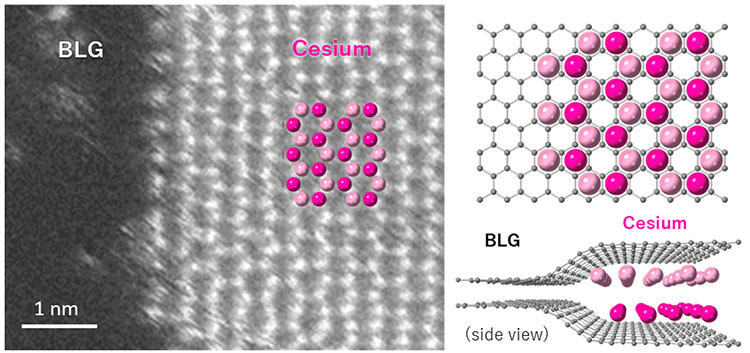[ad_1]
Mar 18, 2024
(Nanowerk Information) Researchers at AIST, in collaboration with Osaka College, Tokyo Polytechnic College, Kyushu College, and Nationwide Tsing Hua College, have developed a way to insert alkali metals into the interlayers of graphene. They’ve succeeded in straight observing the atomic association of the inserted alkali metallic atoms which is a hexagonal shut packed bilayer construction.
The findings have been revealed in Nature Communications (“Alkali metallic bilayer intercalation in graphene”).

Alkali metals kind a hexagonal close-packed bilayer when inserted into bilayer graphene. Left: Scanning transmission electron microscope (STEM) picture of cesium atoms inserted between bilayer graphene (prime view). Proper: Atomic mannequin of alkali metals in bilayer graphene (prime view). (Picture: AIST)
The efficiency of rechargeable batteries is a key issue influencing the driving distance of electrical automobiles and the utilization time of smartphones. Bettering the efficiency of those digital units is feasible if rechargeable batteries can accumulate better electrical capacities. Graphite, the electrode materials utilized in batteries, consists of multilayers of graphene, with alkali metals positioned between the layers to facilitate the stream of electrons throughout charging and discharging. Reaching a excessive density of alkali metals storage between graphene layers may improve the electrical capability.
For the previous hundred years, it has been well known via X-ray and electron diffraction measurements that graphene interlayers can solely accommodate a single layer of alkali metallic. Every layer being totally stuffed by single layer alkali metallic atoms is taken into account the theoretical charging restrict. Nevertheless, there have been no experiences of research straight observing the atomic association of interlayer alkali metals and confirm whether or not graphene layers can solely accommodate a single layer of alkali metallic atoms or whether or not different strategies can obtain larger density or a number of layers of alkali metals.
The group developed a way to insert dense alkali metals between graphene layers. Using a high-performance low-voltage (60 kV) electron microscope, they’ve efficiently noticed the association construction of alkali metallic atoms between the graphene layers. The alkali metals are discovered densely packed in a two-layer construction in each bilayer graphene and within the floor layer graphite because of the versatile extension capability of their interlayer spacing. This enables roughly twice as many alkali metals to be inserted. If graphene with two layers of alkali metallic insertion may be stacked, it’s anticipated to function an electrode materials enhancing the capability of alkaline ion secondary batteries.
[ad_2]
Supply hyperlink




